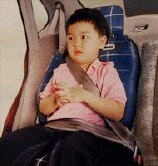
WEDNESDAY, April 29, 2015 (HealthDay News) — As you plan summer car trips with your young children, you should also consider car seat safety.
Car seats reduce the risk of death in infants and children by up to 71 percent, the U.S. Centers for Disease Control and Prevention says. But CDC research suggests 72 percent of car and booster seats are used improperly, which reduces their effectiveness.
Using a seat belt instead of a car seat for young children can be dangerous. “No matter how short the trip, if your child is in the car, he or she should be in a child safety seat,” said Dr. Bridget Boyd, assistant professor of pediatrics at Loyola University Chicago Stritch School of Medicine.
“If your child is shorter than 57 inches, a seat belt will lay across the child’s neck and belly,” Boyd noted in a Loyola news release. “In the event of an accident, this puts pressure on sensitive areas with the potential for serious injuries, including spinal cord and abdominal injuries, or even death.”
Boyd said recent changes to improve safety can be confusing for parents. Here, she offers tips:
- Keep your child’s age, height and weight in mind when you choose a car seat. From birth to 2 years, a rear-facing car seat in the back seat is appropriate. From ages 2 to 5, or until a child has reached the upper height and weight limit for a seat, the child belongs in a forward-facing seat with a harness (a “convertible car seat”) in the back seat.
- A booster seat is appropriate when children are too big for the forward-facing harness seat but not ready for a seat belt because it doesn’t fit properly. Seat belts fit when the lap belt goes across the upper thigh, not the stomach, and the shoulder belt goes across the chest, not the neck. In general, seat belts properly fit people taller than 57 inches (4 feet 9 inches).
- For the highest level of safety, children who don’t need a booster seat belong in the back seat until they’re 13.
- Visit seatcheck.org to find a location near you — often a police or fire station — that will check and install a car seat for you.
- Don’t use car seats more than 6 years old.
“Car seats and seat belts really could mean the difference between life and death for kids and parents,” Boyd said. “Many of us remember running to the car yelling ‘first’ to nab the front seat, but it’s safest to not even let the front seat be an option for kids, even if they are older.”
Be a good role model, she added. “Talk about safety with your kids. It can make a world of difference,” she said.
More information
For more about car seat safety, try the American Academy of Pediatrics.
Copyright © 2025 HealthDay. All rights reserved.

